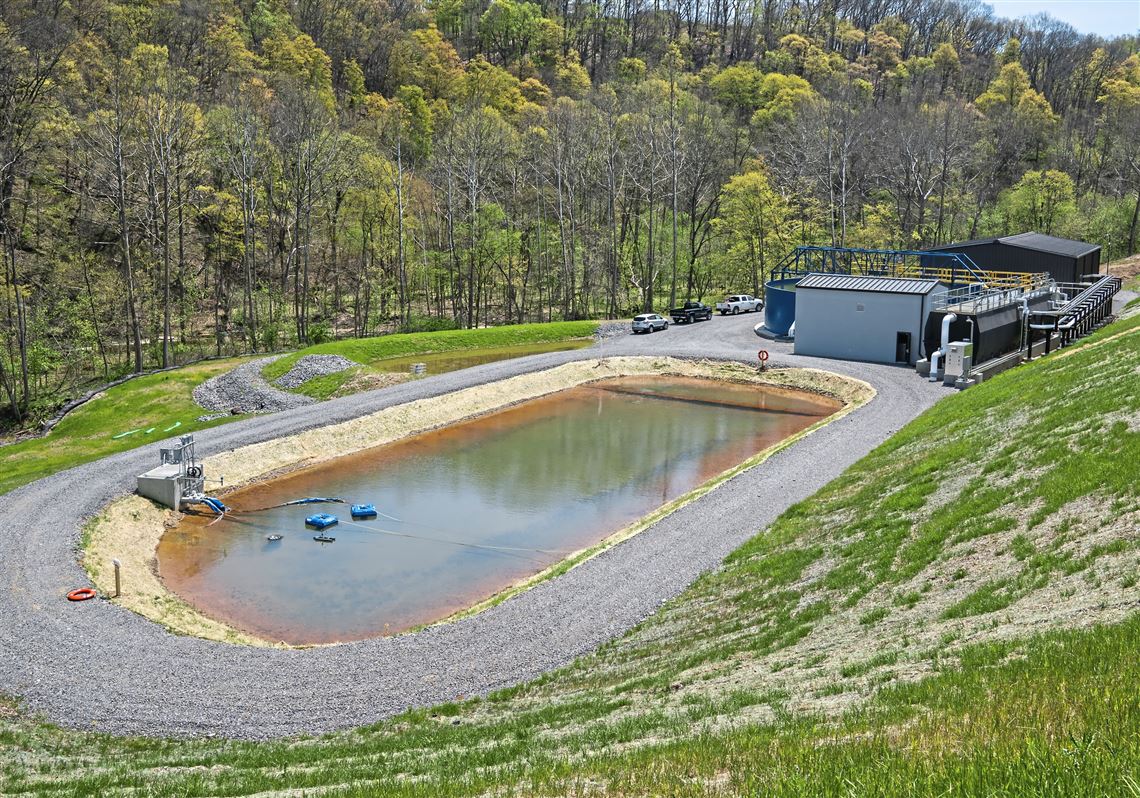Millers Run ran bright orange in South Fayette, the result of iron washed out of a century-old labyrinth of abandoned deep mines.
The creek’s color was so much a part of the area’s identity for so long that businesses were named after it — the Orange Creek Diner and the Iron Creek Bar.
Those businesses are history now, and, thanks to the $13 million Gladden mine drainage treatment facility that began operating in January and was dedicated Tuesday, so is the orange tint on the lower 4 miles of Millers Run and another 4 miles of Chartiers Creek, which receives that flow.
“The legacy of the orange creek is behind us now,” said John Alan Kosky, who grew up along “Millers Run Crick” and would often come home with fingers and toes stained orange by the flow. “Now we can begin to utilize the creek for recreational activities.”
The new treatment plant, tucked in a narrow valley, just behind The Original Farmers Market pavilion, off Route 50 on land donated by Mr. Kosky, can treat up to 2 million gallons of abandoned mine water and remove 690 pounds of iron a day.
The Gladden discharge is the largest of the more than half-dozen discharges in the Millers Run and Chartiers Creek watersheds, and accounts for up to 30% of all the abandoned mine pollutants entering those streams, according to Thomas Gray, a program manager with Tetra Tech Inc., an international environmental consulting firm.
The company was hired by the South Fayette Conservation Group to design, build and operate the treatment plant for a year. The local citizens organization was formed in 2003 with the goal to restore the water quality of Millers Run and a tributary, Fishing Run, which flowed into an open mine portal. The first phase of the Gladden discharge project successfully rerouted Fishing Run out of the mine and into a surface channel in 2009.
“Now, more than 10 years later and thanks to the efforts of many individuals with the group, we finally have a clean stream that runs through South Fayette,” said Stephen Frank, the organization’s president. “We can now turn our focus on securing funds for long-term operation of the treatment system and completing additional projects so that the community can recreate along the banks of Millers Run.”
Pennsylvania Department of Environmental Protection Secretary Patrick McDonnell said the success of the Millers Run project underscores the importance of restoring other local waterways in the state.
“What was once a fantasy to fish and recreate on these sections of Millers Run and Chartiers Creek,” he said, “is closer to reality, thanks to the group of dedicated partners gathered here today.”
Michael Nerozzi, director of policy and planning for the Pennsylvania Fish and Boat Commission, said fisheries biologists will conduct testing on about 8 miles of Millers Run and Chartiers Creek downstream of the treatment plant discharge point this fall.
“If the water quality has sufficiently improved, we could begin stocking these two new sections with trout as soon as the 2022 season,” Mr. Nerozzi said, adding that trout have been stocked upstream of the discharge point for a number of years.
The iron-laden water is pumped out of the Maude #2 Mine, lowering the underground mine pool so it does not flow into Millers Run. Instead, the mine water is piped under Route 50 to the treatment plant, which uses hydrogen peroxide, a chemical oxidizer, to rapidly precipitate dissolved iron and other metals from the mine water in a 350,000-gallon clarification tank. The treated water is discharged to Millers Run and the iron is pumped back underground to another part of the mine void.
Money to design and build the treatment plant and operate it for the first year was provided in a grant from the federal Abandoned Mine Drainage abatement and treatment program, authorized in the Surface Mining Control and Reclamation Act and the Abandoned Mine Land Economic Revitalization Program, which specifically targets abandoned mine cleanup projects that are linked to local community and economic development goals.
The annual operating costs for the treatment plant will run close to $300,000, said Farley Wood, Tetra Tech senior project manager.
“The federal and state funds provided were expediently turned into tangible results for the community that will have a lasting impact,” Mr. Wood said.
Thomas Shope, Appalachian regional director of the Office of Surface Mining Reclamation and Enforcement, said the federal Abandoned Mine Land Trust Fund, which provides money to clean up and reclaim abandoned mine land and toxic, mine-tainted water throughout Appalachia and Western mining states, will expire on Sept. 30 unless Congress reauthorizes it.
He said the cost of restoring known abandoned mine land and mine water discharges is estimated at $11 billion nationally, with $5 billion of that in Pennsylvania. The fund currently has a $2.2 billion balance.
Bipartisan legislation has been introduced to extend the trust fund, established in 1977, and its assessment of 28 cents a ton for surface mined coal and 12 cents a ton for deep mined coal, another 15 years until 2036.
“We’ve seen what orange water can do and its impacts to the environment and economy. In areas like this it’s become part of the landscape.” Mr. Shope said. “This project can generate an economic revitalization. People today want, demand and deserve clean water, and that can generate new housing and transportation infrastructure. This project will have an impact on the area for many years to come.”
Don Hopey: dhopey@post-gazette.com.
First Published: April 27, 2021, 10:15 p.m.
















